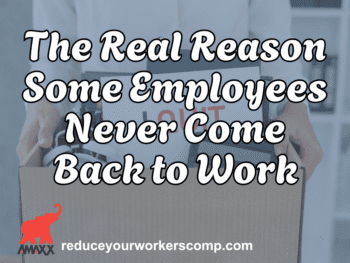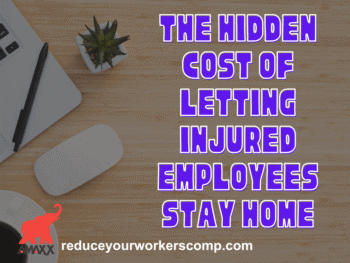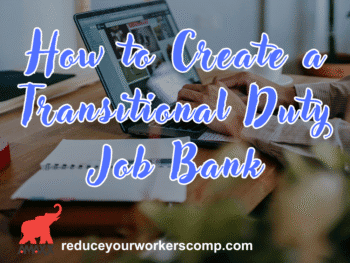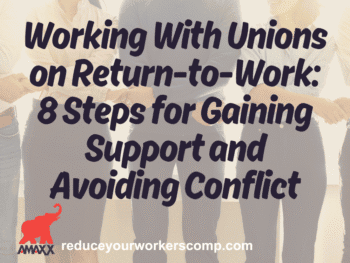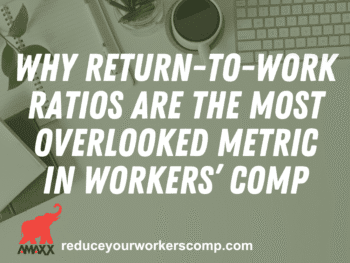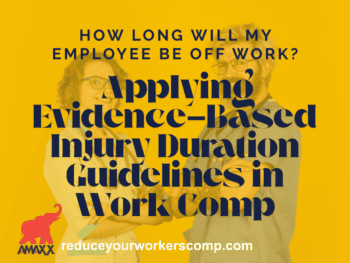Register for Live Stream WC Mastery Training:
-
The No Hold Barred Definitive Guide to Return to Work Best Practices
- Tuesday, April 24, 2018, at 2:00 pm EST
When worker’s compensation was created over 100 years ago as the first form of social insurance in America, the number one reason and goal of the program was to return employees to their pre-injury state. Number one reason and number one goal of worker’s compensation was to return employees to their pre-injury state, both medically and from an occupation standpoint, their ability to work.
Hello, my name is Michael Stack, CEO of Amaxx. And if that is the truth, which it is, the number one goal of worker’s compensation is to return employees to their pre-injury state, the best way to do that is with a very effective return to work program. Now there’s a lot we could talk about with return to work. There’s a lot of different nuances, but what I want to discuss today is where I see companies falling down the most. And that’s right out of the gates in the policy, in the transitional duty policy, and the strategy and the philosophy as to how an organization even looks at setting up a return to work in the first place. Because if you’re not doing this right out of the gates, then you’re setting yourself up for failure, or at least you’re setting yourself up to not be as successful and have things run as smoothly as they could.
4 Foundational Elements of Return to Work Success
We’re going to cover four critical elements to return to work or transitional duty policy that you need to have implemented at your organization to set things up properly. Let’s talk about what these are.
Temporary
First thing is it needs to be temporary. Return to work needs to be temporary, and this should be no more than 90 days. The vast majority of healing should be occurred in most injuries … of course, you need to be flexible on this in order to accommodate for the ADA … but as you’re communicating this, as you’re setting this up, the vast majority of cases, temporary transitional duties should last no more than 90 days. And if you’re not on that path, then you need to bring up some other claim interventions to get things going in the right direction. So number one is temporary.
Similar to Employee’s Current Position and Flexible
Number two is it needs to be similar to their current position. As you’re looking at creating a transitional duty job, the first place to look is that it’s similar to their current job. Look at the functional abilities that you get from their provider, from the medical provider, and match that up to what they do. Make sure that they can continue to be productive as an employee. The first place to look is that modifying and making it similar to their original job. But you also need to be flexible in this same breath. Ask that employee what part of your job can you do today? Get those functional abilities from the medical provider, and maybe you can’t modify their original job, which happens. You also need to have the ability to possibly move them to a different division within your own organization or possibly at a different charity so they can get back to work right away, doing something that’s productive as for the society as a whole, helps their healing, as well. So temporary, similar and flexible.
Occurs During Regular Business Hours
Number three then is that it’s during regular business hours. Transitional duty occurs during regular business hours, and this is a typical workday. Regular business hours, Monday through Friday, 9:00 to 5:00 or 9:00 to 6:00, whatever your hours are at your organizations. So there’s no overtime that happens with a transitional duty job and no second shift, as well. So no overtime, no second shift. If someone’s on a transitional duty job, it’s happening during regular business hours. It lets you be able to monitor that individual employee, lets you be able to communicate with them better, and really puts them in and taps them into the ability to tap into medical providers, etc.
Condition of Employment
And the last thing here, element number four is that it’s a condition of employment. Return to work is a condition of employment. Now you think about this as if this person wasn’t injured, do you require them to come to work every day? What if they just said, “Well, I don’t feel like coming to work. I don’t feel like going in today. I’m not really feeling that great. I don’t feel like coming to work.” That’s unacceptable from an employment standpoint. Being paid as an employee, you have to come to work. The same thing is true in a transitional duty policy, as well.
Again, I’m Michael Stack, CEO of Amaxx, and if you can incorporate these four elements into your transitional duty policy, you will be well on your way to success in the most critical element to worker’s compensation management. Remember your work today in worker’s compensation can have a dramatic impact on your company’s bottom line. But it will have a dramatic impact on someone’s life. So be great.

Contact: mstack@reduceyourworkerscomp.com.
Workers’ Comp Roundup Blog: https://blog.reduceyourworkerscomp.com/
©2018 Amaxx LLC. All rights reserved under International Copyright Law.
Do not use this information without independent verification. All state laws vary. You should consult with your insurance broker, attorney, or qualified professional.


